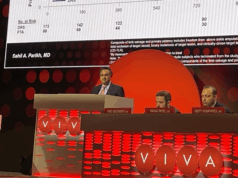
A comment from Andrew Holden (Auckland City Hospital, Auckland, New Zealand) conveyed surprise at new cost-effectiveness data from the BEST-CLI trial that were shared at the 2025 Charing Cross (CX) Symposium (23–25 April, London, UK). The findings were revealed as part of a series of four podium-first presentations from the landmark BEST-CLI and BASIL-2 trials delivered at the meeting that aimed to add nuance to the ongoing conversation around the best treatment option for chronic limb-threatening ischaemia (CLTI) patients.
Sharing the main conclusion to be drawn from new BESTCLI cost-effectiveness data, Matthew Menard (Brigham and Women’s Hospital, Boston, USA) shared with the CX 2025 audience: “I can tell you that, based on the data that we have—with the caveat that the final results are pending—we would predict that open will prove to be slightly superior to endo[vascular] with regard to cost per life year gained and that endo[vascular] will be slightly superior to open with regard to cost per quality-adjusted life year gained.”
Topline results from this trial were shared at the American Heart Association (AHA) scientific sessions in 2022, with investigators revealing that surgical bypass with adequate single-segment great saphenous vein is a more effective revascularisation strategy for patients with CLTI who are deemed suitable for either an open or endovascular approach. Both strategies were deemed safe and effective for CLTI treatment.
At CX, Menard added a further prediction that “given the small and statistically insignificant magnitude of the differences in the relevant inputs, it is very unlikely we will detect any meaningful cost-effectiveness difference,” noting that more granular data will be released later in the year.
Holden, who was moderating the session, homed in on these findings during discussion time. “Before you shared these data,” he said, “I intuitively thought that endovascular, while not being successful overall, was going to be more cost-effective and I thought it would be driven by lower hospital stay and certainly lower intensive care stay, but you actually found the opposite, so I find that counterintuitive.”
Holden asked Menard whether he could explain the findings, to which Menard responded that “our goal was to undertake a very comprehensive analysis,” in which all costs associated with the initial index procedure and hospitalisation were captured, along with all of the costs of follow-up reinterventions, hospitalisations, and rehabilitation care. “The challenge is figuring out what’s relevant to the disease,” he said, adding that “this is how the data are looking” when all of the costs that are associated with CLTI revascularisation are assessed in aggregate over time. “Hospital stay,” he stressed, “which is almost always the key driver in costeffectiveness analyses, appears to be the key metric in our evaluation as well.”
BASIL-2 triallist Matthew Popplewell (University of Birmingham, Birmingham, UK) noted that he was “quite relieved” on hearing the new findings. He explained that the length of stay in the BASIL-2 health economic analysis has been criticised for being “really long”, with the suggestion being that this could be due to a healthcare system issue. “Clearly it’s not, because it’s happening on both sides of the pond,” Popplewell commented.
Holden added that a “new lesson” to take from these cost-effectiveness data is that the driver of shorter hospital stay in these patients is perhaps not a less invasive procedure but instead making progress with wound healing to facilitate discharge.
Subsequently, Alik Farber (Boston Medical Center, Boston, USA) shared a new subset analysis from BEST-CLI. “We found that primary endo[vascular] may actually burn bridges for secondary bypass,” the presenter concluded, noting that primary bypass was associated with “significantly better” outcomes.
A question from the audience probed whether there are enough granular data available to know how a primary endovascular intervention “actually burns the bridge”. Farber responded: “There are many potential reasons as to how endovascular therapy may burn bridges for a future bypass. It may occur due to disruption of vulnerable plaque, wire injury, compromise to collateral vessels, damage to runoff vessels, compromise of a bypass target, progression of tissue loss and concomitant loss of optimal window for intervention, or it could simply be a marker for a higher risk patient or disease pattern. Which of these reasons are at play is not clear; however, our findings do show that the amputation rates are higher after secondary bypass.”
Here, Farber pointed to future research that might bring answers. He shared that the Novo Nordisk Foundation has provided a grant to the BEST-CLI team to fully unpack the BEST-CLI dataset.
Menard added that the National Institutes of Health (NIH) has granted the BEST-CLI team permission to look more closely at the first major adverse limb events (MALE) data in the trial. He remarked: “We have been able to obtain the source data and so will be able to look at the aetiology of treatment failures. We are hopeful this will help us understand the important questions related to the need for reinterventions following an initial open or endovascular revascularisation.”
Summarising this part of the discussion, Holden remarked: “I think it’s fair to say that we are learning that endo[vascular] may burn bridges, and I never used to like to hear that, but I think it is potentially true.”
Elsewhere in the session, Popplewell shared for the first time the outcomes of the 61 patients treated conservatively who were screened for BASIL-2 as part of the BASIL prospective cohort study. He noted that this figure represented 13% of those screened for the trial at the lead institution, a proportion that was “a lot bigger” than the researchers were expecting. These patients, he explained, were not amputated, nor was any attempt made to revascularise them due to frailty or lack of options.
Popplewell concluded that patients managed conservatively in this group were “more likely to be older, female and sicker, and less likely to receive best medical therapy” than those who underwent infrainguinal revascularisation.
Initial results from this trial were presented at CX 2023, with the main conclusion being that a patient who needs a below-the-knee revascularisation with or without a femoropopliteal revascularisation is likely to do better if they are treated with a best endovascularfirst strategy rather than a vein bypass-first approach if clinicians had clinical equipoise between the two strategies.
At CX 2025, Popplewell also shared BEST-CLI and Global Limb Anatomic Staging System (GLASS) angiographic scoring data from BASIL-2.
He concluded that over two-thirds of patients enrolled in BASIL-2 had GLASS stage II or III disease, adding that half had mild or minor femoropopliteal disease, while one-third had long femoropopliteal occlusive disease.
The presenter also reported that most (two-thirds) of the tibial disease in the least diseased artery was confined to less than one-third of the vessel or short occlusions of less than 3cm in length and that the majority had some form of pedal arch. He noted that there were no significant differences in presentation between those patients treated with either best endovascular therapy or vein bypass.
Discussion following the four presentations considered whether clinical practice has changed following the release of BEST-CLI and BASIL-2 data.
“Anecdotally,” Farber shared, “I can tell you that it has,” while acknowledging that it is as yet hard to give an evidence-based answer to this “important” question.
Panellist Robert Hinchliffe (University of Bristol, Bristol, UK) stated that it should be possible to track any change in practice in the UK via the National Vascular Registry (NVR).
Menard commented that “it seems like people are listening” while noting it “obviously depends on who you talk to”. He acknowledged that there are specialists who are reluctant to change practice regardless of what the evidence says and that there is a “huge educational challenge” moving forward. “Hopefully it’s not going to take 10 years, which is the average for guidelines to affect practice,” he said.
Referencing some data on the topic, Menard noted that within the Vascular Quality Initiative (VQI)—which he recognised is “not necessarily the perfect place to look” because it only represents around 50% of providers in the USA—it “definitely seems like there’s an uptick” in bypasses.
Taking a step back, Popplewell stressed that there is a need to “act carefully” and refrain from “blanketly applying” the results of the two studies to all CLTI patients. “I think we have to remember that these are a subset of patients with CLTI where we have genuine equipoise between two different strategies,” he said.
Holden shared that he and his team are now “more rigorous” with assessment of conduits. Hinchliffe agreed on this takeaway message, noting: “In terms of the algorithm for evaluation, conduit assessment is absolutely key early in the assessment and evaluation phase.”











